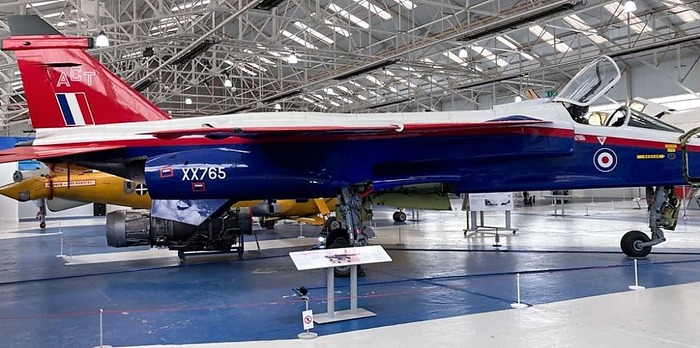VISITING RAF COSFORD
- Kate

- Sep 15, 2022
- 4 min read
Updated: Sep 19, 2022
The RAF Museum is home to over 75 historic aircraft, but you don’t have to be a military aviation expert to enjoy RAF Cosford: there is plenty here for the more casual visitor, especially one interested in the history of the air force and the role it has played in world events since the Great War.

There are plenty of aircraft on show outside as you approach the first hangar, including a Catalina flying boat and a Lockheed Neptune. Once inside there is a brief history of the RAF’s first 100+ years, beginning with the formation of the Royal Flying Corps in 1914 through its emergence as the RAF in 1918 to its role in the present day.

This hangar then offers the visitor, for £5 each, the chance to “experience all the thrills and exhilaration of powered flight”. There is the opportunity to fly in a Spitfire in a virtual reality setting, and also the 4D experience of flying with the Red Arrows.
There were rather terrifying sounds emerging from this attraction (happily the vibration and clunks of machinery rather than the cries of the “airborne” occupants) but it was proclaimed “amazing” by those emerging, even if they looked a little shaken. You could also experience a Typhoon Simulator and/or the Paradrop VR – a journey “flying” under a canopy which takes the brave passenger over cities, mountains, deserts and through outer space.
The second hangar displays some of the early combat aircraft – including a Great War Sopwith Pup – before moving on to the Battle of Britain aircraft. There is plenty of information about the “Few” and, as you would expect, a Submarine Spitfire – this one being the world’s oldest surviving Spitfire, taking its first flight on April 1939. There is detail about how the Dowding Defence system operated to get fighter planes into the air during the crucial months of 1940.
A Hawker Hurricane is exhibited – Hurricanes in fact shot down 60% of enemy aircraft, more than all the air and ground defences combined. A German dive bomber, the Junkers Ju 88, is also on display in this hangar as well as a Messerschmitt, the Me410. A de Havilland Mosquito and other aircraft also come from this era and the only Boulton Paul Defiant in the world is here. There is a Yokosuka Ohka single-seat rocket-powered suicide attack aircraft of the type used by the Japanese in their suicide missions against American shipping in the Pacific. Display cabinets include some artefacts and leaflets from the Home Front as well as mascots once carried by the airmen.
The Cold War hangar is full of interest. The aircraft are interspersed with small hubs which explain much of the background to the planes that were operational during this period from 1946 to 1990 when the spectre of nuclear war haunted the world. The story begins with the development of the Manhattan Project and the early testing of atomic bombs.
All three British V bombers are on show here – Vulcan, Victor and Valiant and the English Electric Lightning suspended vertically. You may be lucky, as we were, and encounter a veteran looking at the display who is willing to share knowledge and experience. Standing beside the Vickers Valiant XD818 was the navigator plotter who had been a member of the crew that had tested a hydrogen bomb over Maiden Island in 1957.

One hub explains the concept of MAD – Mutually Assured Destruction - another gives the story of the Campaign for Nuclear Disarmament showing the Aldermaston marches and the protests by the women of Greenham Common. One gives graphic detail and pictures about the 13 Days of tension of the Cuban Missile Crisis of 1963. There is information about the Berlin Wall and Checkpoint Charlie, and a hub concentrating on the Space Race between east and west.
Any visitor who may have less interest in the technicalities and specifications of the planes will surely appreciate the successful placing of these aircraft in their political and historical context.
This museum is amazingly good value. It is supported by the Ministry of Defence and therefore free, although all donations are welcome. Any costs entailed are for the carpark or the flight “experiences”. There are several knowledgeable and enthusiastic volunteers on hand to answer questions. Exhibitions are regularly changing – for example a Falklands Exhibition is running in 2022, and there are often air shows in the summer months. There is an imaginative play area if you have young children with you.
Visiting RAF Cosford
Lysander Avenue, Cosford, Shropshire, TF11 8UP
01902 376200
Entrance to the Museum is free.
By car: Easy access from the M6 southbound at Junction 12, northbound at Junction 10a. Only 30 minutes from the centre of Birmingham or 10 minutes from Telford. Not all SATNAV systems recognise the postcode so WV7 3EU is an alternative. The car park costs £5.
By rail: Cosford is on the Birmingham to Shrewsbury Line with ½ mile walk to the Museum.
By bus: 891 from Wolverhampton and Telford
By bike: The Museum is on National Cycle Route 81 from Wellington to Albrighton
Facilities available on site include a café and licensed restaurant












Comments